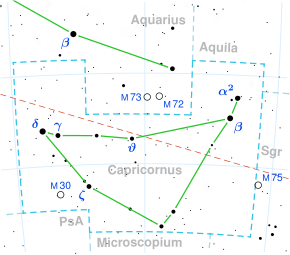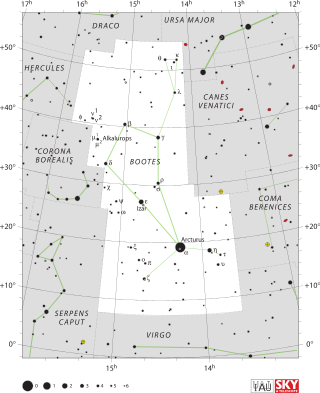
Boötes is a constellation in the northern sky, located between 0° and +60° declination, and 13 and 16 hours of right ascension on the celestial sphere. The name comes from Latin: Boōtēs, which comes from Greek: Βοώτης, translit. Boṓtēs 'herdsman' or 'plowman'.

The Leonids are a prolific annual meteor shower associated with the comet Tempel–Tuttle, and are also known for their spectacular meteor storms that occur about every 33 years. The Leonids get their name from the location of their radiant in the constellation Leo: the meteors appear to radiate from that point in the sky. Their proper Greek name should be Leontids, but the word was initially constructed as a Greek/Latin hybrid and it has been used since. The meteor shower peak should be on 17 November, but any outburst in 2023 is likely to be from the 1767 meteoroid stream.
Zodiacal light is a faint glow of diffuse light in the sky scattered by interplanetary dust, particularly a zodiacal cloud, along the ecliptic, and therefore the zodiac. It is mostly only visible in very dark conditions across the night sky along the whole ecliptic as the zodiacal band, backscattered slightly brighter from an oval area of the band directly opposite to the light source as the gegenschein and brightest as a triangle-shaped area at the horizon around the light source as false dawn, mostly just before or after the Sun rises or sets.

A meteoroid is a small rocky or metallic body in outer space. Meteoroids are distinguished as objects significantly smaller than asteroids, ranging in size from grains to objects up to a meter wide. Objects smaller than meteoroids are classified as micrometeoroids or space dust. Many are fragments from comets or asteroids, whereas others are collision impact debris ejected from bodies such as the Moon or Mars.

Andromeda is one of the 48 constellations listed by the 2nd-century Greco-Roman astronomer Ptolemy, and one of the 88 modern constellations. Located in the northern celestial hemisphere, it is named for Andromeda, daughter of Cassiopeia, in the Greek myth, who was chained to a rock to be eaten by the sea monster Cetus. Andromeda is most prominent during autumn evenings in the Northern Hemisphere, along with several other constellations named for characters in the Perseus myth. Because of its northern declination, Andromeda is visible only north of 40° south latitude; for observers farther south, it lies below the horizon. It is one of the largest constellations, with an area of 722 square degrees. This is over 1,400 times the size of the full moon, 55% of the size of the largest constellation, Hydra, and over 10 times the size of the smallest constellation, Crux.

A meteor shower is a celestial event in which a number of meteors are observed to radiate, or originate, from one point in the night sky. These meteors are caused by streams of cosmic debris called meteoroids entering Earth's atmosphere at extremely high speeds on parallel trajectories. Most meteors are smaller than a grain of sand, so almost all of them disintegrate and never hit the Earth's surface. Very intense or unusual meteor showers are known as meteor outbursts and meteor storms, which produce at least 1,000 meteors an hour, most notably from the Leonids. The Meteor Data Centre lists over 900 suspected meteor showers of which about 100 are well established. Several organizations point to viewing opportunities on the Internet. NASA maintains a daily map of active meteor showers.
The Quadrantids (QUA) are a meteor shower that peaks in early January and whose radiant lies in the constellation Boötes. The zenithal hourly rate (ZHR) of this shower can be as high as that of two other reliably rich meteor showers, the Perseids in August and the Geminids in December, yet Quadrantid meteors are not seen as often as those of the two other showers because the time frame of the peak is exceedingly narrow, sometimes lasting only hours. Moreover, the meteors are quite faint, with mean apparent magnitudes between 3.0 and 6.0.
The Taurids are an annual meteor shower, associated with the comet Encke. The Taurids are actually two separate showers, with a Southern and a Northern component. The Southern Taurids originated from Comet Encke, while the Northern Taurids originated from the asteroid 2004 TG10, possibly a large fragment of Encke due to its similar orbital parameters. They are named after their radiant point in the constellation Taurus, where they are seen to come from in the sky. Because of their occurrence in late October and early November, they are also called Halloween fireballs. Since 2P/Encke is such a short period comet, the meteors have the slowest impact speed of the annual well-known meteor showers.

8P/Tuttle is a periodic comet with a 13.6-year orbit. It fits the classical definition of a Jupiter-family comet with an orbital period of less than 20 years, but does not fit the modern definition of. Its last perihelion passage was 27 August 2021 when it had a solar elongation of 26 degrees at approximately apparent magnitude 9. Two weeks later, on September 12, 2021, it was about 1.8 AU (270 million km) from Earth which is about as far from Earth as the comet can get when the comet is near perihelion.
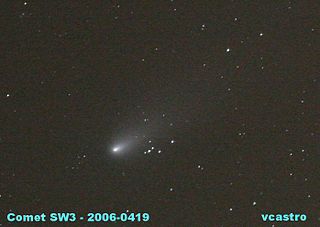
73P/Schwassmann–Wachmann, also known as Schwassmann–Wachmann 3 or SW3 for short, is a periodic comet that has a 5.4 year orbital period and that has been actively disintegrating since 1995. When it came to perihelion in March 2017, fragment 73P-BT was separating from the main fragment 73P-C. Fragments 73P-BU and 73P-BV were detected in July 2022. The main comet came to perihelion on 25 August 2022, when the comet was 0.97 AU from the Sun and 1 AU from Earth. It will be less than 80 degrees from the Sun from 25 May 2022 until August 2023. On 3 April 2025 it will make a modest approach of 0.3 AU to Jupiter. 73P will next come to perihelion on 23 December 2027 when it will be 0.92 AU from the Sun and on the far side of the Sun 1.9 AU from Earth.
169/NEAT is a periodic comet in the Solar System. It is the parent body of the alpha Capricornids meteor shower in Late July. 169/NEAT may be related to comet P/2003 T12 (SOHO). 169P is a low activity comet roughly a few kilometers in diameter. It could have originated from the main asteroid belt.
The October Draconids, in the past also unofficially known as the Giacobinids, are a Northern hemisphere meteor shower whose parent body is the periodic comet 21P/Giacobini-Zinner. They are named after the constellation Draco, where they seemingly come from. Almost all meteors which fall towards Earth ablate long before reaching its surface. The Draconids are best viewed after sunset in an area with a clear dark sky.
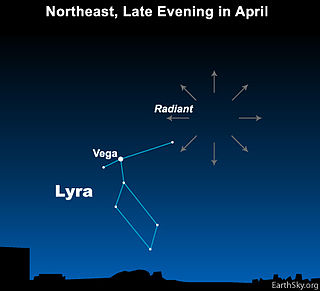
The April Lyrids are a meteor shower lasting from about April 15 to April 29 each year. The radiant of the meteor shower is located near the constellations Lyra and Hercules, near the bright star Vega. The peak of the shower is typically around April 22–23 each year.

Petrus Matheus Marie (Peter) Jenniskens is a Dutch-American astronomer and a senior research scientist at the Carl Sagan Center of the SETI Institute and at NASA Ames Research Center. He is an expert on meteor showers, and wrote the book Meteor Showers and their Parent Comets, published in 2006 and Atlas of Earth’s Meteor Showers, published in 2023. He is past president of Commission 22 of the International Astronomical Union (2012–2015) and was chair of the Working Group on Meteor Shower Nomenclature (2006–2012) after it was first established. Asteroid 42981 Jenniskens is named in his honor.
The Andromedids meteor shower is associated with Biela's Comet, the showers occurring as Earth passes through old streams left by the comet's tail. The comet was observed to have broken up by 1846; further drift of the pieces by 1852 suggested the moment of breakup was in either 1842 or early 1843, when the comet was near Jupiter. The breakup led to particularly spectacular showers in subsequent cycles.
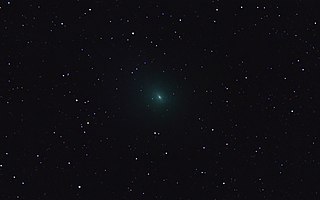
45P/Honda–Mrkos–Pajdušáková is a short-period comet discovered by Minoru Honda December 3, 1948. It is named after Minoru Honda, Antonín Mrkos, and Ľudmila Pajdušáková. The object revolves around the Sun on an elliptical orbit with a period of 5.25 years. The nucleus is 1.3 kilometers in diameter. On August 19 and 20, 2011, it became the fifteenth comet detected by ground radar telescope.

The Tau Herculids are a meteor shower that when discovered in 1930 appeared to originate from the star Tau Herculis. The parent comet of the Tau Herculids is periodic comet Schwassmann-Wachmann 3 with a 5.4 year orbital period. This meteor shower occurs from May 19 - June 19. The meteor shower was first observed by the Kwasan Observatory in Kyoto, Japan in May 1930. The Tau Herculids' average radiant was α=236°, δ=+41°. Due to orbital perturbations of the meteor streams by Jupiter, 2022 activity will have a radiant of R.A. = 13:56 (209), Decl. = +28. The meteors are relatively slow moving making atmospheric entry at around 16 km/s (36,000 mph).

The Alpha Monocerotids is a meteor shower active from 15 to 25 November, with its peak occurring on 21 or 22 November. The speed of its meteors is 65 km/s, which is close to the maximum possible speed for meteors of about 73 km/s. Normally it has a low Zenithal Hourly Rate (ZHR), but occasionally it produces much more intense meteor storms that last less than an hour: such outbursts were observed in 1925, 1935, 1985, and 1995. The 1925 and 1935 storms both reached levels passing 1,000 ZHR.

Comet 252P/LINEAR is a periodic comet and near-Earth object discovered by the LINEAR survey on April 7, 2000. The comet is a Jupiter family comet, meaning that it passes quite close to the orbit of Jupiter.

CAMS is a NASA-sponsored international project that tracks and triangulates meteors during night-time video surveillance in order to map and monitor meteor showers. Data processing is housed at the Carl Sagan Center of the SETI Institute in California, USA. Goal of CAMS is to validate the International Astronomical Union's Working List of Meteor Showers, discover new meteor showers, and predict future meteor showers.
